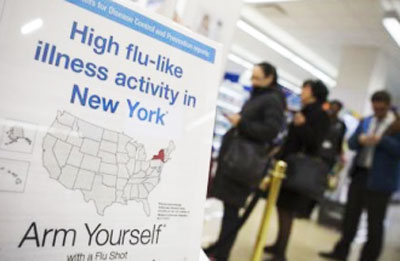
Flu reaches epidemic level in US
Washington, January 12, 2013
Influenza has officially reached epidemic proportions in the United States, with 7.3 per cent of deaths last week caused by pneumonia and the flu, the US Centers for Disease Control and Prevention said.
The early start and fast spread of flu this season - especially after 2011-2012's very mild outbreak - has overwhelmed doctors' offices and hospitals, forcing some patients to wait through the night to be seen in emergency departments.
Nine of the 10 US regions had "elevated" flu activity last week, confirming that seasonal flu has spread across the country and reached high levels several weeks before the usual late January or February, CDC reported.
Only one region - the Southwest and California - had "normal" flu activity last week.
Tens of thousands of Americans die every year from flu, even in non-epidemic years. The threshold for an epidemic is that it causes more than 7.2 per cent of deaths, but as yet there is no definitive count of the total caused by flu this year.
In Boston, flu cases are 10 times higher than they were last year, causing Mayor Thomas Menino to declare a public health emergency on Wednesday.
In Illinois, 24 hospitals struggling to cope with the flood of flu cases had to turn away people arriving in the emergency department, while in Pennsylvania, the Lehigh Valley Hospital outside Allentown has set up a tent for people who arrive with less-severe flu.
A total of 20 children have now died from this season's flu, up two from the previous week, the CDC said. That compares to 34 during the full 2011-2012 flu season and 282 during the severe 2009-2010 season.
The outbreak has led to attempts at prevention that go beyond the standard advice of getting vaccinated, avoiding contact with sick people and frequently washing hands with soap.
In Boston, the Catholic Archdiocese has told priests they could suspend the offering of communion wine using a shared chalice and bow rather than shake hands while exchanging the Sign of Peace, a Christian greeting.
Auxiliary Bishop Robert P. Deeley urged priests to use hand sanitizer before and after communion and to avoid touching congregants' tongues or hands. He said parishioners who were ill "should remain at home and return to church when they are well."
While flu vaccines offer protection, they are not failsafe.
This year's flu vaccine is 62 per cent effective, scientists reported on Friday in the CDC's weekly publication, meaning that almost four in 10 people who receive the vaccine and are exposed to the virus will nevertheless become infected.
This is considered "moderate" effectiveness and is in line with previous years' flu vaccines, which range from 50 per cent to 70 per cent effective, Dr. Joseph Bresee, chief of the CDC's influenza division, told reporters.
Experts recommend the vaccine for everyone over 6 months of age. Even if it does not prevent flu, immunization can reduce the severity of the illness, preventing pneumonia and other life-threatening results of flu.
Public health authorities were correct in their forecast of which flu strains would emerge this season and therefore what vaccine to make: one that contains two strains of influenza A and one strain of influenza B. An A strain, called H3N2, predominates this season, though the B strain has caused about 20 percent of cases.
About 10 per cent of cases have been caused by a B strain that is not in the vaccine, which "has space for only three strains," CDC Director Dr. Tom Frieden said.
Dr. Arnold Monto of the University of Michigan, a co-author of the vaccine-effectiveness study told Reuters this year's vaccine was "a good vaccine, but not a great vaccine."
It is less effective for the frail elderly, for people receiving chemotherapy for cancer, and for people taking oral steroids, as their immune systems have been weakened and are often unable to produce an effective number of antibodies in response to the vaccine.
One reason flu vaccines are far from perfect, said Monto, is where in the body the viruses find a home - congregating on the surface of small airways in the respiratory tract, while virus-fighting antibodies that are stimulated by vaccines mostly stay in the bloodstream.
According to the most recent CDC data, 37 per cent of Americans - 112 million people - had received the flu vaccine as of mid-November.
Of the 135 million doses produced this year, 128 million have been distributed to doctors' offices, drug stores, clinics and other facilities.
Although public health officials believe enough doses were produced, some spot shortages have developed. "You may have to call a few places," before finding one with vaccine, said the CDC's Bresee, "but it should be available."
In its weekly flu update on Friday, the CDC reported that 24 of the 50 US states as well as New York City had experienced "high activity" in flu-like illnesses last week. In 16 states, activity was moderate, while in 10 it was low or minimal.
The 24 states reporting high activity was down from 29 the previous week, raising hopes that the disease may have peaked in some regions, particularly the Southeast, and that a flu season that began early may also end early. It typically starts in December, peaks in January or February and peters out by late March or early April.
The percentage of visits to healthcare providers last week for flu-like illness - 4.3 per cent - is comparable to that during the 2007-2008 flu season, which was characterized as "moderately severe" but which peaked some two months later.
By comparison, in the 2009 H1N1 "swine" flu pandemic, 7.7 per cent of visits were for flu-like illness.-Reuters







